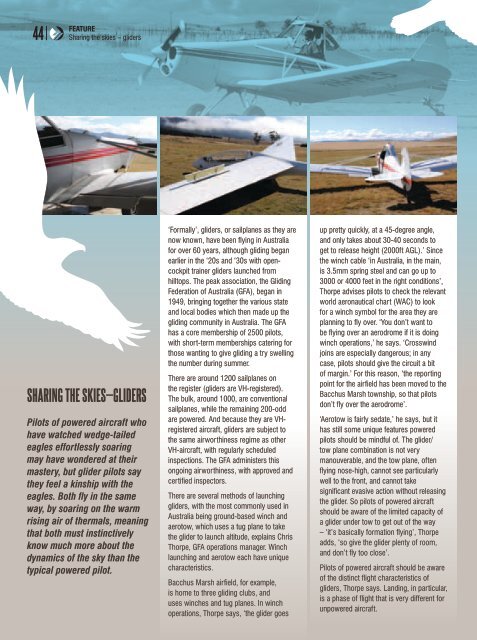jul-aug2012
Create successful ePaper yourself
Turn your PDF publications into a flip-book with our unique Google optimized e-Paper software.
44<br />
FEATURE<br />
Sharing the skies – gliders<br />
Sharing the skies—gliders<br />
Pilots of powered aircraft who<br />
have watched wedge-tailed<br />
eagles effortlessly soaring<br />
may have wondered at their<br />
mastery, but glider pilots say<br />
they feel a kinship with the<br />
eagles. Both fly in the same<br />
way, by soaring on the warm<br />
rising air of thermals, meaning<br />
that both must instinctively<br />
know much more about the<br />
dynamics of the sky than the<br />
typical powered pilot.<br />
‘Formally’, gliders, or sailplanes as they are<br />
now known, have been flying in Australia<br />
for over 60 years, although gliding began<br />
earlier in the ‘20s and ‘30s with opencockpit<br />
trainer gliders launched from<br />
hilltops. The peak association, the Gliding<br />
Federation of Australia (GFA), began in<br />
1949, bringing together the various state<br />
and local bodies which then made up the<br />
gliding community in Australia. The GFA<br />
has a core membership of 2500 pilots,<br />
with short-term memberships catering for<br />
those wanting to give gliding a try swelling<br />
the number during summer.<br />
There are around 1200 sailplanes on<br />
the register (gliders are VH-registered).<br />
The bulk, around 1000, are conventional<br />
sailplanes, while the remaining 200-odd<br />
are powered. And because they are VHregistered<br />
aircraft, gliders are subject to<br />
the same airworthiness regime as other<br />
VH-aircraft, with regularly scheduled<br />
inspections. The GFA administers this<br />
ongoing airworthiness, with approved and<br />
certified inspectors.<br />
There are several methods of launching<br />
gliders, with the most commonly used in<br />
Australia being ground-based winch and<br />
aerotow, which uses a tug plane to take<br />
the glider to launch altitude, explains Chris<br />
Thorpe, GFA operations manager. Winch<br />
launching and aerotow each have unique<br />
characteristics.<br />
Bacchus Marsh airfield, for example,<br />
is home to three gliding clubs, and<br />
uses winches and tug planes. In winch<br />
operations, Thorpe says, ‘the glider goes<br />
up pretty quickly, at a 45-degree angle,<br />
and only takes about 30-40 seconds to<br />
get to release height (2000ft AGL).’ Since<br />
the winch cable ‘in Australia, in the main,<br />
is 3.5mm spring steel and can go up to<br />
3000 or 4000 feet in the right conditions’,<br />
Thorpe advises pilots to check the relevant<br />
world aeronautical chart (WAC) to look<br />
for a winch symbol for the area they are<br />
planning to fly over. ‘You don’t want to<br />
be flying over an aerodrome if it is doing<br />
winch operations,’ he says. ‘Crosswind<br />
joins are especially dangerous; in any<br />
case, pilots should give the circuit a bit<br />
of margin.’ For this reason, ‘the reporting<br />
point for the airfield has been moved to the<br />
Bacchus Marsh township, so that pilots<br />
don’t fly over the aerodrome’.<br />
‘Aerotow is fairly sedate,’ he says, but it<br />
has still some unique features powered<br />
pilots should be mindful of. The glider/<br />
tow plane combination is not very<br />
manouverable, and the tow plane, often<br />
flying nose-high, cannot see particularly<br />
well to the front, and cannot take<br />
significant evasive action without releasing<br />
the glider. So pilots of powered aircraft<br />
should be aware of the limited capacity of<br />
a glider under tow to get out of the way<br />
– ‘it’s basically formation flying’, Thorpe<br />
adds, ‘so give the glider plenty of room,<br />
and don’t fly too close’.<br />
Pilots of powered aircraft should be aware<br />
of the distinct flight characteristics of<br />
gliders, Thorpe says. Landing, in particular,<br />
is a phase of flight that is very different for<br />
unpowered aircraft.

















